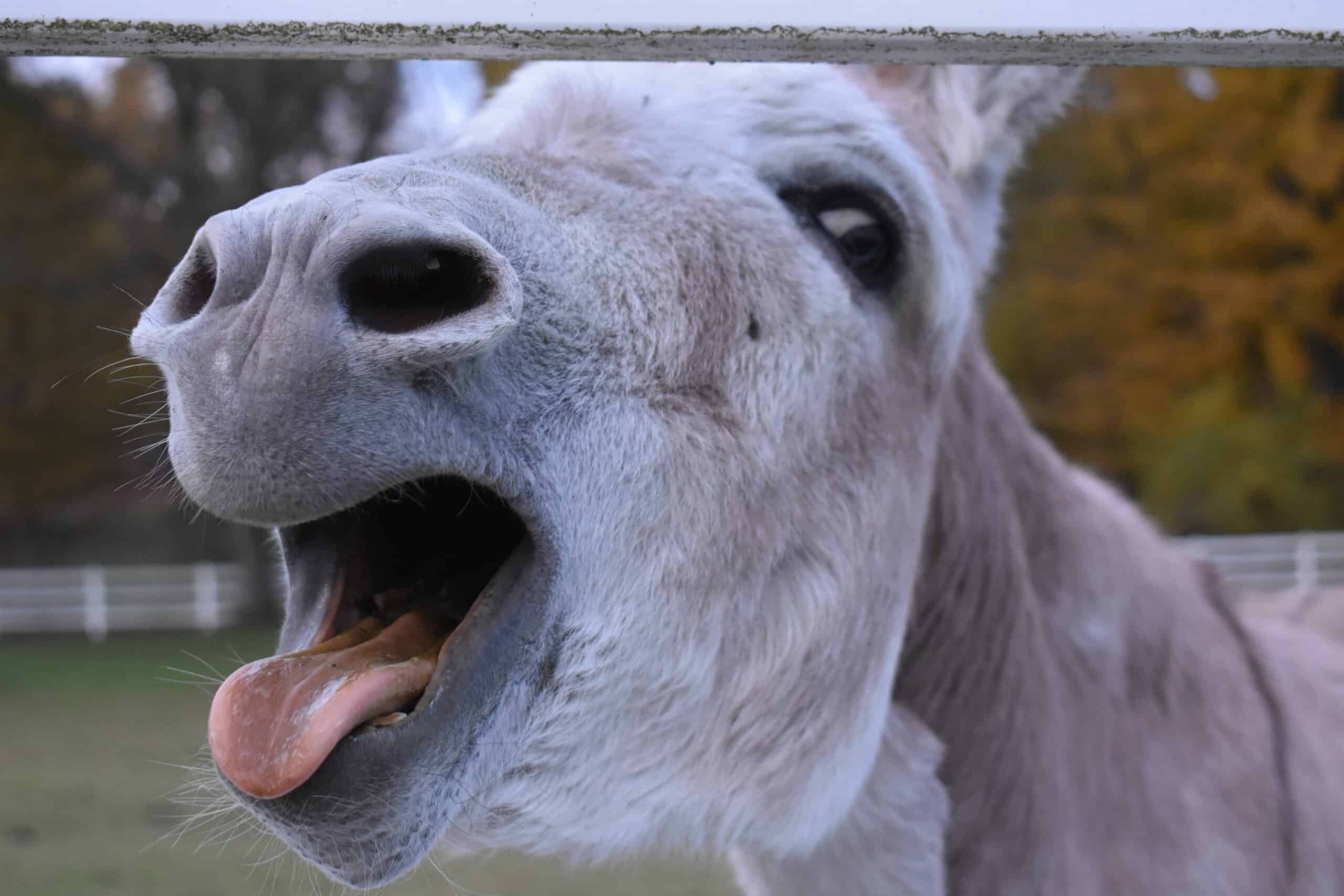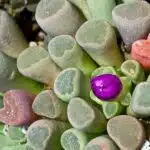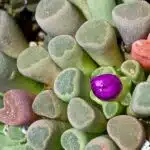From its home in the mountains of Mexico, the Donkey’s Tail (Sedum Morganianum) has become a popular choice for gardeners who want to add something special and unique to their garden. It is commonly referred to as Burro’s Tail or Lamb’s Tail and is one of the most sought after succulents due to its unusual appearance. In fact, over 11% of all succulent sales are for this plant species!
If you are looking for an easy-to-care-for plant that will bring interest and color to your garden, then the Donkey’s Tail might be just what you’re looking for! This guide will provide you with all the information you need on how to grow and care for this unique succulent. We will cover topics such as where it grows best, how much light it needs, how often it needs watering, and more. With these tips in hand, you’ll have everything you need to give your new Donkey’s Tail a healthy start in life!
Donkey’s Tail is a great choice if you are looking for a low maintenance plant with interesting foliage and beautiful flowers that add color and texture to any environment. So if you’re ready to learn more about growing this amazing succulent, let’s get started!
What Is Donkey’S Tail?
Donkey’s Tail, also known as Sedum Morganianum, is a succulent plant native to Mexico. It’s a trailing or climbing vine that can be grown in a pot or hanging baskets. Its leaves are thick and fleshy, with small star-shaped flowers that bloom in the summer. The stems have a unique look because of their plumpness and bumps on them.
Donkey’s Tail is extremely easy to care for and grow; you just need to follow a few basic guidelines. This succulent is drought tolerant and doesn’t require much water or fertilizer. It thrives in partial sun and prefers soil with good drainage. It should also be planted at least 4 inches away from other plants so it has room to spread out its stems.
Propagating this plant is simple too; you can take stem cuttings and place them into moist soil until they take root. With proper care, Donkey’s Tail will add an interesting texture to your garden that you’ll enjoy for years! Now that you know what it is and how to care for it, let’s talk about where does Donkey’s Tail grow best?
Where Does Donkey’S Tail Grow?
Donkey’s tail is an enchanting succulent with its cascading stems and vibrant green leaves. It’s a symbol of perseverance, with its ability to survive and thrive in all kinds of weathers. Donkey’s tail loves being grown outdoors, creating a magical addition to any outdoor space with its captivating beauty.
Where does donkey’s tail grow? Well, it’s native to Mexico but can be grown anywhere that has warm temperatures, good drainage and plenty of sunshine. Here are 3 tips for successful growing:
- Provide the plant with enough light – it needs at least 4-6 hours of sunlight per day.
- Plant in well-draining soil – use a cactus potting mix or create your own by mixing one part compost and two parts sand.
- Water regularly – during the summer months, water the plant once a week; during the winter months, water every 2-3 weeks.
These tips should help you get started on your journey to growing donkey’s tail. With patience and effort, you will be rewarded with a beautiful display of nature! To ensure your succulent retains its vibrancy, make sure to provide it with the right environment and adequate care – this will keep it healthy for years to come! Let’s move on to how to plant donkey’s tail.
How To Plant Donkey’S Tail
Who would have thought that a plant with the peculiar name of “donkey’s tail” could provide so much pleasure? Unfortunately, it can also be difficult to grow and care for this succulent if you don’t know what you’re doing. But no worries; with the right information, even beginners can become experts in growing donkey’s tail!
Planting donkey’s tail is actually easy once you know the basics. First, find a location with bright but indirect sunlight, such as a windowsill or patio. Then make sure your pot has adequate drainage holes, and fill it with well-draining soil. Next, take your donkey’s tail cuttings from healthy plants and remove any leaves from the bottom of the stem. Finally, insert the cuttings into your soil about one inch deep and cover them lightly with soil before watering. With just a few simple steps, you’ll soon see your donkey’s tail thrive!
Now that you’ve got your donkey’s tail planted, it’s time to make sure it gets all the sun it needs to stay healthy. The amount of sunlight required depends on the type of plant you have – some may need more than others – but generally speaking, four hours per day should be enough. Just remember to always keep an eye on your plants to ensure they’re not getting too much or too little sun!
Sun Requirements For Donkey’S Tail
It is often believed that Donkey’s Tail plants need a great deal of sun in order to thrive. However, it is important to recognize that these succulents can also grow quite well in areas with indirect sunlight, making them an excellent choice for home gardeners who don’t have the luxury of having full sun exposure. Here are 4 key requirements for growing and caring for Donkey’s Tail plants:
Place the plant in an area with at least 4-5 hours of direct or indirect sunlight each day.
Provide adequate air circulation around the plant to help reduce the risk of fungal diseases.
Maintain consistent moisture levels by watering every 2-3 days during the hot summer months and once a week during cooler months.
Cover your plants with a light shade cloth during periods when temperatures exceed 90°F (32°C).
These factors will help ensure that your Donkey’s Tail plants receive the right combination of heat and light for optimal growth. Additionally, it is important to keep in mind that these succulents are sensitive to overwatering, so make sure not to let them sit in waterlogged soil for too long or they may start to rot. With proper care, you can enjoy watching your Donkey’s Tail plants thrive! Now let’s turn our attention towards understanding the soil requirements needed for keeping these plants healthy.
Soil Requirements For Donkey’S Tail
Soil is the foundation of any plant. It’s important to make sure your donkey’s tail is planted in soil that has the right balance of nutrients and drainage. In this section, we’ll discuss what kind of soil you should be looking for and how to prepare it for planting.
When selecting a potting mix for your donkey’s tail, look for one with a good mix of organic material and mineral content. A well-draining potting soil that has a combination of peat moss, perlite, vermiculite, or coarse sand will help provide an environment for optimal growth. Additionally, adding compost or aged manure can help boost nutrient levels and improve the quality of the soil.
Before planting in your new potting mix, it’s best to condition it first by mixing in water until it forms a moist consistency. This will ensure that your donkey’s tail has access to all the necessary nutrients as soon as it’s planted. With these tips in mind, you can rest assured that you’re giving your donkey’s tail the ideal home it needs to thrive.
Next up we’ll discuss what kind of watering requirements are best suited for this succulent species so get ready to give your donkey’s tail the hydration it deserves!
Watering Requirements For Donkey’S Tail
Thriving Donkey Tail plants require proper watering to grow and flourish. As with any other plant, the key is moderation and consistency. Watering too much or too little can both lead to poor health. Like Goldilocks, you have to find the right amount of water for your plant – not too much, not too little.
To do this, you need to get familiar with the soil type and its water-holding capacity. In general, cactus soil will provide good drainage for a Donkey Tail plant, but it is also important to monitor the moisture level during dry periods as it may require more frequent watering than other succulents.
A good way to check for moisture is by using a moisture meter or simply poking your finger into the soil about an inch deep. If the soil feels dry, it’s time to give your plant a drink. Make sure not to over-water as this can lead to root rot and other diseases that can harm your donkey tail’s health. A metaphor I like to use when talking about watering: “Watering a succulent is like giving someone compliments – Too much and they feel overwhelmed; Too little and they might feel neglected”
TIP: You should try providing just enough water such that you see some runoff at the bottom of the pot so that excess salts will be flushed out of your plant’s roots! This helps prevent mineral buildup which can cause root rot in succulents over time.
Fertilizing Requirements For Donkey’S Tail
Fertilizing your donkey’s tail is as easy as pie and can help it flourish in its new home. Like a prized racehorse, giving your plant the right nutrients will get it off to a great start.
Giving your donkeys tail the proper nourishment is essential to its health and longevity. A balanced fertilizer, preferably one that is slow-release, should be applied every two to four weeks during the growing season. However, you should also fertilize your donkey’s tail after pruning or if it looks like it may not be getting enough nutrients from the soil. An organic fertilizer, such as fish emulsion or compost tea, can also be used to give your plant an added boost of nutrients.
When fertilizing your donkey’s tail, make sure that you do so sparingly. Too much fertilizer can burn the leaves and cause nutrient deficiencies for the plant in the long run. When applying , water the soil before and after applying fertilizer to ensure that it gets properly absorbed into the soil. Additionally, avoid using harsh chemical fertilizers on your donkey’s tail as these can damage its delicate foliage over time. With just a bit of extra care and attention, you can keep your donkey’s tail healthy and thriving for years to come!
Pruning Requirements For Donkey’S Tail
Pruning is an important part of the care and maintenance of Donkey’s Tail, a unique succulent that gives a hanging cascades look to any space. This process can help ensure the plant looks its best while keeping it healthy.
To start, you should prune your Donkey’s Tail at least once every six to eight weeks. It’s important to use sharp pruning shears for this step in order to avoid damaging the plant. You should also make sure to wear protective gloves when handling your succulent, as some species may have sharp spines and leaves that could cause injury if not handled with care.
When trimming off the ends of the stems, you should cut just above where a leaf is growing so that new growth can be encouraged from that spot. This will help keep your plant looking fuller and more balanced. If you notice any stems or leaves that have become diseased or damaged, make sure to remove them immediately in order to prevent further spread of disease or damage throughout the rest of your plant. With regular pruning, you can keep your Donkey’s Tail looking its best!
Taking steps like these can help protect this unique succulent from pests and diseases that could potentially affect it – something we’ll talk about next.
Pests And Diseases That Affect Donkey’S Tail
Though it may seem like a daunting task, caring for donkey’s tail is actually quite straightforward. By following some basic steps, you can ensure that your succulent will remain healthy and vibrant. In particular, pests and diseases can wreak havoc on donkey’s tail, but with proper precautions in place, you can protect them from any harm.
That said, let’s take a look at the types of pests and diseases that affect donkey’s tail. While these plants are generally hardy and resistant to most problems, they are still susceptible to certain issues. The most common pests include mealybugs, scale insects, aphids, whiteflies and thrips. These insects feed on the leaves and stems of the plant by sucking out the sap or eating away at the tissue of the plant which can lead to discoloration or deformities. Additionally, fungal diseases such as root rot or pythium can occur if the succulent is kept in overly moist conditions for too long.
Fortunately though, there are ways to prevent these problems before they become an issue. To control pests like mealybugs and aphids, it is important to keep your succulent clean by regularly wiping down its leaves with a damp cloth or cotton swab dipped in rubbing alcohol. For fungal diseases like root rot or pythium, be sure to water sparingly and never let the soil become overly saturated with moisture. If you follow these tips and take precautions against potential pests and diseases, your donkey’s tail should stay healthy for years to come!
Now that we understand how to keep our donkey’s tail free from pests and disease, it’s time to learn about propagating them so we can share this beautiful succulent with others!
Propagating Donkey’S Tail
Propagating donkey’s tail is like replicating a miracle. Its cascading foliage and its vibrant hues of purple and green are truly awe-inspiring. Here are some tips to help you propagate your own donkey’s tail:
• Cut the stem carefully with a clean pair of scissors • Dip the cut end in a rooting hormone • Plant it in a potting mix with well-draining soil • Place the pot in indirect sunlight and keep moist
To ensure success, it’s important to do regular maintenance on your donkey’s tail. Watering the plant evenly but not excessively will help prevent root rot. Pruning is also essential for maintaining its shape and size. To prune, make sure to cut back any dead or dying stems and leaves at their base. This will encourage new growth and keep your donkey’s tail healthy!
It may take time before you see any new shoots, but patience is key when propagating this fascinating succulent. With proper care and attention, you’ll soon have an abundance of these beautiful plants in no time!
How To Harvest Donkey’S Tail
Harvesting donkey’s tail is a simple process, but it requires great care and attention. It’s essential to harvest at the right time to ensure that your plants remain healthy and strong. You don’t want to wait too long or else you could risk damaging the plant or even killing it! But if you do it correctly, you can get beautiful results.
The best time to harvest donkey’s tail is when the leaves start to turn yellowish-brown. At this point, the stems will be tender enough for clipping without causing any damage. Gently snip off each stem with scissors or pruners at its base. Be sure not to pull on the stems as this may cause them to break off.
Once you’ve harvested your donkey’s tail, it’s important to properly store them until you’re ready to use them in your garden or home. Put the cuttings in a breathable container like a paper bag and keep them away from direct sunlight and heat sources. With proper storage, your cuttings should last several weeks before needing to be replanted again. Now that you know how to harvest donkey’s tail, stay tuned for tips on how best to use them in your next project!
Uses For Donkey’S Tail
Donkey’s tail is a succulent plant that can add a unique, exotic flair to any garden. It’s an eye-catching addition that has tons of potential uses beyond simply looking attractive. Like many succulents, donkey’s tail is easy to care for and can be quite versatile if you know how to make use of it. So, let’s take a look at some of the creative applications for this beautiful plant.
As anyone who’s seen it knows, donkey’s tail has an abundance of cascading stems off of which sprout vibrant clusters of leaves. This makes it perfect for adding texture and interest to areas where you need more visual pop. You can hang it in clusters from top shelves or window sills, or attach individual stems directly to walls with adhesive hooks or other fasteners. The sky’s the limit!
Finally, you can even pot your donkey’s tail in indoor planters and add it as a centerpiece on coffee tables or sideboards. The main thing is that you keep it out of direct sunlight and provide enough water without making the soil soggy. With proper care, you’ll be able to enjoy your donkey’s tail for years to come — so don’t hesitate to get creative!
Tips For Growing Donkey’S Tail
Donkey’s tail, or Sedum morganianum, is a unique succulent that is becoming increasingly popular as a houseplant. This interesting plant is quite easy to care for, and it will reward its owners with long trails of draping stems and green leaves. One interesting statistic to note is that donkey’s tail can grow up to 5 feet long when cared for properly! With just a few simple tips, you can ensure your donkey’s tail grows lush and healthy.
The main thing to remember when caring for donkey’s tail is that it needs plenty of light and very little water. Place it in bright, indirect sunlight for at least 4 hours per day. During the summer months, you can place the plant in direct sunlight but be sure to keep an eye out for signs of sunburn. When watering your donkey’s tail, wait until the soil feels dry before adding any water. Overwatering can lead to root rot so err on the side of caution when watering.
In addition to providing adequate light and water, don’t forget about feeding your donkey’s tail every once in a while. Use a diluted liquid fertilizer once or twice a month during spring and summer to help promote growth and flowering. Pruning is also important; cut off any yellowed or dead leaves regularly as this will improve air circulation around the plant which prevents disease from forming. With these simple tips, you can ensure your donkey’s tail looks healthy and vibrant! Now let’s move onto discussing common varieties of donkey’s tail…
Common Varieties Of Donkey’S Tail
It’s ironic that a plant named after an animal has almost nothing to do with them! Donkey’s tail is actually a variety of succulent, known for its trailing stems and small pink flowers. But, don’t worry — growing it doesn’t require the same kind of care and attention you’d need for a real donkey’s tail.
The most common varieties are Sedum morganianum, Burrito or Burro’s Tail, and Sedum rubrotinctum or Jelly Beans. Each one is distinct in appearance, so you can choose your favorite based on its look. Sedum morganianum is a trailing succulent with fleshy leaves that can grow up to 36 inches long. It produces small pink flowers in the summertime. Meanwhile, Burrito or Burro’s Tail has shorter leaves and grows more compactly than Sedum morganianum. Lastly, Jelly Beans have chubby teardrop-shaped leaves that come in shades of green and red.
No matter which variety you choose to grow, Donkey’s Tail is sure to add interest and texture to your home garden or windowsill! With proper care and maintenance — such as providing adequate sunlight, water, and drainage — you can ensure that this unique succulent stays healthy for many years to come. Now let’s move on to troubleshooting Donkey’s Tail so you can learn how to address persistent problems with these plants.
Troubleshooting Donkey’S Tail
As the name implies, Donkey’s Tail is an eye-catching, trailing succulent with ‘tails’ of green leaves, tipped with bright pink. While it’s easy to care for, there are a few things to keep in mind when troubleshooting common problems with this plant. To ensure that your Donkey’s Tail is happy and healthy, here are some tips:
Firstly, take into account its environment. This plant prefers bright indirect sunlight or partial shade and requires well-draining soil. If you notice the leaves wilting or turning yellow, it could be indicative of too much direct sunlight or poor drainage. Secondly, the plant should be watered infrequently but deeply. Allowing the soil to dry out between watering sessions will help prevent root rot and overwatering. Lastly, watch out for pests like mealybugs and spider mites which can damage the leaves and stunt growth if left untreated.
To protect your Donkey’s Tail from potential harm, make sure to inspect plants regularly for any signs of distress or discoloration. Prune away any dead foliage as needed and check for pests by dipping a cotton swab in rubbing alcohol and wiping down leaves and stems. Additionally, repotting every 1-2 years can help prevent overcrowding of roots which can inhibit growth over time. With proper care and attention, your Donkey’s Tail will thrive!
Frequently Asked Questions
How Often Should I Water Donkey’S Tail?
Caring for a donkey’s tail is easy and rewarding, as it offers vibrant foliage with minimal effort. But understanding when to water your plant is essential for its health and growth. In this article, we’ll cover how often you should be watering your donkey’s tail to keep it looking its best.
When it comes to watering a donkey’s tail, the key is to ensure the soil stays slightly moist but not soggy. A good rule of thumb is to water when the top inch of soil begins to feel dry. Depending on environmental conditions such as temperature and air circulation, this could mean watering once every 5-7 days in summer, and every 7-10 days in winter.
To check if it’s time for a drink, stick your finger into the soil up to the first knuckle – if the soil feels dry it’s time to water. It’s important not to overwater as this can cause root rot which can harm or even kill your plant. So make sure you only water when necessary and that you don’t leave any standing water at the bottom of the pot after you’ve watered!
By following these simple tips, you can make sure that your donkey’s tail gets just enough water while avoiding potential issues caused by over or under-watering. With loving care and attention, your Donkey’s Tail will reward you with beautiful foliage for years to come!
What Temperature Range Is Suitable For Donkey’S Tail?
Donkey’s tail is a succulent that can bring a lot of visual interest to your home. But before you start growing it, it’s important to know the temperature range suitable for this plant. According to research, donkey’s tail grows optimally when temperatures are between 65 and 80 degrees Fahrenheit.
This temperature range allows the plant to thrive and produce its beautiful foliage. The warmer temperatures also provide more growth potential and will help the plant establish itself in your home. It’s important to keep in mind that if the temperature drops below 65°F, the growth of your donkey’s tail will slow down significantly and may even stop altogether.
For optimal health, ensure that you don’t expose your donkey’s tail to temperatures much higher than 80°F as it could cause wilting or leaf drop. To prevent these problems, make sure you keep your plant in an area with good air circulation and avoid places where direct sunlight hits it for long periods of time. Also, keeping the soil dry during hot days is essential for keeping your donkey’s tail healthy and happy. With proper care, you can enjoy watching this unique succulent grow lushly in no time!
Is Donkey’S Tail Toxic To Animals Or Humans?
Well, it’s time to answer the million-dollar question: Is donkey’s tail toxic to animals or humans? You bet your bottom dollar that I’m gonna tell ya! It’s like a game show, only with more plants.
Let’s start with the good stuff. Donkey’s tail is not toxic to animals or humans – thank goodness! That being said, every living thing has its limits – and this plant isn’t an exception. Like all succulents, it needs a balance of sun and shade, water and dryness, in order for it to thrive. Here are some tips for keeping your donkey’s tail happy:
• Sun & Shade: Give your donkey’s tail bright light with several hours of direct sunlight each day. But make sure you also provide some shade from hot afternoon sun; otherwise, the leaves may burn and turn brown.
• Water & Dryness: Water your plant regularly to keep the soil moist but not soggy. Allow the top layer of soil to dry out between watering sessions; otherwise, you risk root rot.
• Pruning: To help control the size of your donkey’s tail and keep it looking neat, trim off any overgrown stems and leaves with clean scissors or pruning shears.
Now that we’ve got that out of the way – let’s get down to business! Growing and caring for donkey’s tail is pretty straightforward once you know what you’re doing; just be sure to stick to these guidelines and try not to overthink things too much. After all, even though donkey’s tails are resilient little plants, they still need a bit of TLC if you want them to look their best!
How Long Does It Take For Donkey’S Tail To Propagate?
The donkey’s tail, scientifically known as Sedum morganianum, is a popular succulent with unique trailing stems and an eye-catching foliage. It’s easy to care for and propagates quickly, but the question remains: how long does it take for donkey’s tail to propagate?
The answer lies in the environment you provide for your donkey’s tail. In ideal conditions, with plenty of light and warmth, it can take just a few weeks for stem cuttings to root and begin growing. The best time to propagate is during the spring or summer months when temperatures are warmest. You should also make sure that your succulent is not overwatered so that rot doesn’t occur.
So, if you want to see your donkey’s tail flourish and trail its way around your garden or windowsill in no time at all – keep it in a sunny spot and maintain consistent watering habits! With a little bit of love and care, you can watch this beautiful plant grow before your eyes!
Is There A Way To Propagate Donkey’S Tail Without Cutting It?
Propagating plants can be a great way to grow more without buying new plants and it’s a great challenge for gardeners. But sometimes the best way to propagate a plant isn’t by cutting it – like with donkey’s tail. So, is there another way to propagate donkey’s tail without cutting it?
Yes! Propagating without cutting is possible with this succulent, and it’s actually quite easy. All you need to do is leave the plant in its pot or planter with some soil and let it sit in indirect sunlight – that’s it! The stems will eventually start growing roots from the nodes, which you can then cut off at the base and replant in fresh soil. It might take a few weeks for this to happen, but eventually you’ll have some extra donkeys tails coming up.
Growing and caring for donkey’s tail can be easy if you take the time to understand its needs. Once you know how much light, water, and fertilizer your donkeys tail needs then you can keep it healthy and even propagate new plants from your existing ones. So if you’re looking for an easy way to expand your collection of succulents then give propagating donkey’s tail without cutting a try!
Conclusion
Donkey’s Tail, also known as Sedum Morganianum, is a beautiful succulent that adds a unique look to any garden or home. With its cascading stems and bright green leaves, it is the perfect addition for those looking to add texture and life to any space. With proper care and attention, this plant can live for many years and provide plenty of interest all year round.
Caring for Donkey’s Tail is relatively easy if you understand the basics of watering, temperature range, toxicity and propagation. By following these tips you can ensure your Donkey’s Tail will thrive in its environment. Like a guardian angel looking over your garden, this succulent will bring joy and beauty to anyone who tends to it with love and care.
Overall, caring for Donkey’s Tail is not only easy but also quite rewarding. It brings an interesting appearance with its cascading stems that makes it stand out from other plants in the garden. With proper care this plant will bring a lifetime of pleasure like a loyal friend, always there to uplift your spirits when you need it the most!





























